Guiding water flows – The Project for the Development of Irrigation System in the Atari Basin Area in Uganda

Summary
The main objective of this solution, launched in 2018, is to ensure farmers’ continued access to clean water for irrigation through the development of irrigation systems in selected locations in the Atari Basin in Uganda. This is with the purpose of addressing the negative effects of climate change and improving the production and productivity of farming communities.
Bulambuli and Kween are two parishes located along the Atari River, which is part of a river basin located to the north of Mount Elgon in eastern Uganda. In these parishes, 77.8% of the population is engaged in agriculture as their primary occupation. Many of the farmers rely heavily on rain-fed agriculture and livestock farming. However, droughts and floods are some of the biggest problems they face in and around the slopes of Mount Elgon, followed by poor farming methods, deforestation, and soil erosion.
In 2018, the Ugandan Ministry of Agriculture, Animal Industry and Fisheries acquired a grant of over 93 billion Ugandan Shillings (approx. US$26 million) from the Japan International Cooperation Agency (JICA) to establish irrigation systems in the Atari basin area. In addition to improving the socio-economic situation of local farmers, the project seeks to eliminate existing conflict among the resource users and reduce the problems related to droughts and floods through the fair distribution of water, readjusting the Atari River to its original river course and reducing the extent of encroachment in the downstream Ramsar area.
The planned irrigation system consists of headworks that contain diversion weirs with gates, a spillway and fishway, and an intake structure equipped with gates. The width of the diversion is wide enough to flush out flood discharge when the gates are fully opened. The gates are manually operated and made of steelwork reinforced with concrete. On the farms, the system consists of main canals, secondary canals and tertiary canals for the irrigation system. The maincanalis also designed and constructed tocollectrun-off water.
Overview
- Location:
- Implementation sites:
-
- Single country
- Single location
- Mountain region:
-
Mount Elgon
- Province:
-
- Eastern Uganda
- Solution scale:
- Ecosystem type(s):
- Solution type(s):
- Sector(s):
- Climate impact(s) addressed:
- Climate impact time-scale(s):
- Main benefit associated with the solution:
- Co-benefit(s) associated with the solution implementation:
- Implementation timeline:
-
- 2018 - 2022
Solution details
Main beneficiaries & outcomes
As the project is still under way, the final impact will not be seen for several years. However, the project aims to benefit approximately 532 households in the two parishes of Bulambuli and Kween. With more access to reliable water for farming, the farmers have increased their production, which has improved food security and their livelihoods through the income generated. The goal of the scheme is to increase the yearly rice production by 5,000 tons to help local farmers both improve their income and general human security, and increase Uganda’s food self-sufficiency.
Planning and implementation
The solution is being implemented under the Ministry of Agriculture, Animal Industry and Fisheries of Uganda as the executing agency in partnership with the Ministry of Water and Environment. Together, these two ministries coordinate with the corresponding district and local governments in the region. The Japan International Cooperation Agency (JICA) is also providing support for building the capacities of targeted communities in the operation and maintenance of the project’s scheme.
During the project design phase, an environmental and social impact assessment was carried out to establish the situation in the region and to plan or adjust the measures to be implemented accordingly.
Finance
The project is primarily funded by Japan International Cooperation Agency (JICA) with partial co-funding by the Government of Uganda for a combined total of US$ 26 million.
Innovation
The solution promotes the use of technology to increase supply of water for agricultural production as means of adapting to changing seasons and droughts.







Comments
There is no content